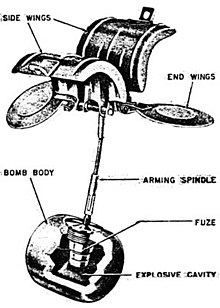

The Butterfly Bomb (or Sprengbombe Dickwandig 2 kg or SD 2) was a German 2-kilogram (4.4 lb) anti-personnel submunition (or bomblet) used by the Luftwaffe during the Second World War. It was so named because the thin cylindrical metal outer shell which hinged open when the bomblet deployed gave it the superficial appearance of a large butterfly.[1] The design was very distinctive and easy to recognise. SD 2 bomblets were not dropped individually, but were packed into containers holding between 6 and 108 submunitions e.g. the AB 23 SD 2 and AB 250-3 submunition dispensers. The SD 2 submunitions were released after the container was released from the aircraft and had burst open. Because SD 2s were always dropped in groups (never individually) the discovery of one unexploded SD 2 was a reliable indication that others had been dropped nearby. This bomb type was one of the first cluster bombs ever used in combat and it proved to be a highly effective weapon. The bomb containers that carried the SD 2 bomblets and released them in the air were nicknamed the "Devil's Eggs" by Luftwaffe air and ground crew.[2]
- ^ Rogers, James I. (2013-06-21). "Remembering the terror the Luftwaffe's butterfly bombs brought to the North". The Guardian. ISSN 0261-3077. Retrieved 2017-02-09.
- ^ "Operation Barbarossa", Jonathan Garraway, Fly Past, Key Publishing, No. 359, June 2001, p. 70